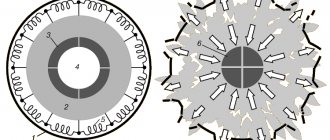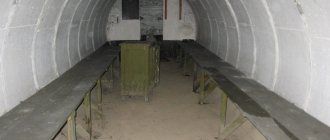The scientific and technological revolution, which began in the middle of the 19th century, radically changed the face of human civilization. Scientific achievements and new technologies have touched almost all areas of human life, significantly improving the quality of life. In a short period of time, a man managed to tame electricity. Physics, chemistry and medicine have reached a completely different, qualitatively new level of applied science, providing humanity with new opportunities to receive civilizational benefits. However, it would be surprising if scientific and technological progress did not affect the military sphere.
In the 20th century, new, more sophisticated types of weapons of mass destruction entered the arena, putting human civilization on the brink of disaster.
Characteristics of weapons of mass destruction
The main criterion for any new type of weapon has always been a greater destructive effect. In modern conditions, it becomes important not only to quickly defeat the enemy through fire confrontation. The first place comes to the damaging factor, the size and scale of which make it possible to disable a large concentration of manpower of a potential enemy within a short period of time.
Such a result can only be achieved using a completely new weapon, which would differ not only in the method of delivery and use on the battlefield, but would also meet the following characteristics:
- high lethality;
- large affected area;
- speed of action;
- the presence of any negative impact on people, animals and the environment;
- presence of negative consequences.
Each new weapon of mass destruction becomes more powerful and lethal to humans. Along with the increase in the destructive power of such weapons, the affected area has increased significantly and long-term damaging factors have intensified. These factors are the main features of weapons of mass destruction that we still deal with today.
The first classical weapon of mass destruction that humanity encountered was chemical or biological weapons. Even in ancient times, when besieging fortresses or defending against enemy invasion, animal excrement and decomposition products of living organisms were used to worsen the sanitary situation in the enemy camp. Following the use of such means of struggle, a sharp decline in morale was observed. Often the combat effectiveness of the troops fell to extremely low levels, making it easier to achieve military success of the campaign. The heavy foul odor and sources of drinking water contaminated with decaying flesh became precisely those damaging factors that massively affected large crowds of people. The history of wars knows many such examples when, instead of armed struggle, the outcome of battles was decided through the use of other means.
Many years later, in modern times, science gave man a more effective method of armed struggle on the battlefield. Thanks to the use of chemically active toxic substances, the military was able to achieve the desired success on the battlefield.
The starting point was the chemical attack of German troops in the area of the Ypres River, which took place on April 22, 1915. Chlorine, which the Germans released from cylinders, was used as a toxic substance. Up to 5 thousand soldiers and officers of the French army died within an hour from the suffocating effect of the gas. Up to 10 thousand people were put out of action, having received poisoning of varying degrees of severity. In a short time, the enemy lost an entire division and a section of the front 15 km long. turned out to be practically broken through. From that moment on, all warring parties began to use chemical weapons, radically changing combat tactics. Instead of chlorine, phosgene and hydrocyanic acid were used, highly toxic substances that increased the destructive power of the new weapon. Despite personal protective equipment (PPE), at least one million people died from chemical weapons during the First World War. The actions of weapons of mass destruction showed the whole world how close man has come to the line beyond which the total destruction of his own kind begins.
Description
The simplest example of a radiological weapon is a “dirty bomb”. Structurally, it is a container containing radioactive isotopes. Their release into the environment occurs as a result of the destruction of the container.
The bomb was equipped with an explosive specifically for this purpose. After the charge is triggered, the shock wave sprays the explosive explosive over a large area. A striking example was the explosion at the Chernobyl nuclear power plant. Then a leak of radioactive substances occurred after the destruction of the reactor, which became a kind of container for ballistic missiles. According to experts, “dirty bombs” can come in a variety of designs. It all depends on what properties the radiological materials have. BRVs are equipped with warheads in missiles and aircraft bombs. They can also be in bombs, shells, mines and other ammunition.
History of the use of weapons of mass destruction
After chemical weapons were successfully demonstrated on the battlefield, chemical warfare agents entered service with almost all armies, becoming one of the weighty arguments of their combat effectiveness.
The consequences caused by the use of chemical weapons during military conflicts led to the fact that already in 1925, an attempt was made at the international level to take control of the use of such dangerous weapons.
During World War II, there were isolated cases of the use of toxic substances; work was carried out in the Japanese Imperial Army and in the laboratories of Nazi Germany to create bacteriological weapons and their subsequent use. However, the apogee of the use of chemical weapons was the Vietnam War, which developed into an environmental war. The United States fought Vietnamese guerrillas for three years, spraying chemical weapons in the form of defoliants over the jungle.
Only in 1993, under the auspices of the UN, was the Convention on the Prohibition of Chemical Weapons signed, which has now been acceded to by 65 states.
Following chemical weapons, which many in the world tried to ban and outlaw, the arsenal of means of mass destruction was replenished with other, more powerful and dangerous types of weapons. For the military, the destruction of enemy personnel and damage to the civilian population was not the main criterion. The question was raised about the possibility of quickly, with one blow, causing irreparable damage to the industrial potential and civilian infrastructure of the enemy. This opportunity was provided by nuclear weapons, which have become one of the most powerful types of weapons today. However, at the same time, today many states own other types of weapons of mass destruction, cheaper in terms of production and methods of use.
The use of weapons with a radiological damaging effect in combat operations
The armies of the United States, Russia and Great Britain are currently armed with projectiles with damaging elements made of depleted uranium-238. Uranium, compared to lead, has almost twice the density, which increases its attractiveness for use in ammunition. At the same time, uranium used for the manufacture of ammunition, although 40% less radioactive than natural, nevertheless, according to formal criteria, falls into the category of radioactive, and weapons that contain it can, if desired, be classified as radiological.
Based on the facts of the use of this type of ammunition during hostilities in Yugoslavia, Iraq, as well as in Syria, relevant accusations have been repeatedly voiced in the media. It was also indicated that uranium is very flammable and when uranium destructive elements hit the target, it burns or disperses (that is, the formation of fine uranium dust), after which disinfection of the area turns out to be very labor-intensive and difficult to implement.
The response to these accusations was usually by pointing to the relatively weak radioactivity of depleted uranium used by the United States and arguing that the radioactivity it introduced was comparable to the natural radioactivity of potash fertilizers or granite facing materials.
Also, Serbian and Russian sources put forward a version that, along with ammunition containing Uranium-238, the US military used similar ammunition based on the much more radioactive Uranium-236, the radiological damaging component of which is undoubted. In particular, such statements were made to journalists by the head of environmental safety of the Armed Forces of the Russian Federation, Lieutenant General Boris Alekseev. The United States has never confirmed the existence of such ammunition modifications in its official sources.
As of 2015, there are no known systematic open studies of the long-term effects of the radiological destructive component of these munitions in the areas where they are used. The question of whether they should be classified as radiological remains the subject of public propaganda discussion.
Main types of weapons of mass destruction
Today, the arsenal of weapons of mass destruction is represented by three main types:
- nuclear weapon;
- chemical weapon;
- bacteriological weapons of mass destruction.
In addition to them, other specific weapons appeared, possessing a number of other damaging factors. In accordance with the variety of damaging factors, a classification of weapons of mass destruction has emerged, which determines the level of protection against weapons of mass destruction, the methods and effectiveness of defense and personal protective equipment.
Types of weapons of mass destruction are classified according to the following principle:
- technological accessibility of production;
- cheap and accessible method of delivery and application;
- selective action, both in time and in type and type of goal;
- the presence of aggravating consequences of the use of weapons of mass destruction for the enemy, including a high psychological and moral effect;
- localization of the use of weapons of mass destruction depending on time, place and circumstances.
In this aspect, nuclear weapons no longer look like the dominant type of weapons, despite their colossal power. Today, a great destructive effect is achieved not only by large-scale physical destruction of objects and the destruction of manpower. An important aspect of the effectiveness of new weapons of mass use is the incapacitation of a certain group of people in a certain territory, causing significant harm to the environment. In addition, it is important to achieve complete or temporary failure of production, financial and social infrastructure on which any economy is based today.
Of the known three main types of weapons of mass destruction, only the first - nuclear weapons - is the most powerful and destructive. The damage from the use of such weapons is colossal, both in terms of the physical destruction of the enemy’s military force and in terms of the destruction of civilian and military facilities. The other two - chemical and bacteriological weapons - are silent killers, destroying mainly all living things.
Today, to the three known types of weapons of mass destruction, completely new means of mass influence on the enemy have been added, among which geophysical and tectonic, climatic and environmental weapons stand out. Hypothetically, weapons of mass destruction could include infrasonic guns and sources of radiological radiation.
Here we are already talking about the selectivity of the action of weapons of mass destruction. In this case, the multifactorial damaging effect is triggered. The main factors of modern types of weapons for mass impact are the period of action, the speed of spread of negative consequences and the large psychological effect. In addition to this, the multifactorial nature of the lethality of modern types of weapons of mass destruction has complicated the search for means to effectively protect troops, the population, and infrastructure from the use of weapons of mass destruction. The possibilities for quickly eliminating the consequences resulting from the use of weapons of mass destruction have become more complicated.
Present tense
Currently, according to official data, a separate type of weapon such as a “dirty bomb” in service with the armies of states does not exist, since it does not give an immediate damaging effect (light radiation, shock wave and other types of effects of atomic weapons) and, therefore, is of little use as a military weapon. The use of a dirty bomb can lead to radiation contamination of soil, water, and areas of radiation sickness over large areas. Clearing the area may take a long time. Exposure to ionizing radiation can lead to mutations in offspring. All this is also not desirable for the state if the war is waged for the sake of conquering territory and obtaining material benefits from the war.
The importance of defenses against weapons of mass destruction
With the development of means and methods of mass destruction of manpower and equipment, protection against weapons of mass destruction has improved. The military quickly managed to adapt to the current situation. With appropriate shelters and protective technical equipment, it was possible to significantly reduce the scale of damage and neutralize the damaging factors of weapons of mass destruction. In the presence of dangers and threats of the enemy using WMD, the system of protection against weapons of mass destruction (WMD), which is an integral attribute of any civil society in modern conditions, began to be improved.
Each type of weapon always entails the appearance of adequate means of protection. The appearance of toxic substances on the battlefield in the First World War led to the improvement of the gas mask, which became a mandatory part of military equipment for many years. Following the technical means of protection, sanitary and medical safety measures also appeared, which significantly reduced the impact of negative consequences on the human body.
The atomic bombing of the Japanese cities of Hiroshima and Nagasaki in August 1945 not only showed the enormous power of the atomic bomb, but also demonstrated to all humanity a number of new damaging factors. This is the first time man has encountered a shock wave of enormous power, penetrating radiation and severe radioactive contamination of a vast territory. We had to urgently look for new, effective means of protection against weapons of mass destruction.
With the beginning of the military-political confrontation between East and West, in parallel with the improvement and increase in the nuclear potential of the leading states, work was actively carried out to create qualitatively new means and methods of protection. On both sides of the Atlantic, in the USA, in Europe and in the countries of the socialist camp, intensive construction of bomb shelters was carried out. In places where army units were deployed, protective structures were built for military equipment; personnel were equipped with new personal protective equipment, new models of military equipment capable of reducing the damaging effect of the use of weapons of mass destruction. Protection against weapons of mass destruction has become an important component of the life of civil society, whether overseas or in the USSR.
Nowadays, people understand much better what radiation is and what consequences could occur if a nuclear conflict occurs on earth. Not everyone knows what electromagnetic radiation is or what the use of tectonic and climate weapons can mean for a person. Although the consequences in this case can be much more serious. The damaging factor from the use of tectonic or climatic weapons in its scale significantly exceeds the capabilities of nuclear weapons. Hurricanes alone annually cause economic damage to states, estimated by experts at hundreds of billions of dollars. The psychological effect of an artificially created drought or flood is no less than that of the threat of using nuclear weapons.
Today, despite the decreased international tension in relations between the leading world powers, the creation of means of effective protection against the consequences of the use of weapons of mass destruction has not been removed from the agenda. Due to the introduction of serious controls on the proliferation of nuclear weapons, control over the use of other types of weapons of mass destruction remains a weak point. Some states are trying to use chemical weapons as a tool of international blackmail. The indulgence of certain political regimes with radical groups of various kinds only increases the threat of using toxic substances as a terrorist attack. The danger of using certain types of bacteriological weapons cannot be discounted either. In both cases, the consequences of such an attack can be fatal for a huge mass of people. Moreover, the main threat in this case hangs over civilian objects and the civilian population.
Testing of radiological weapons elements and their proliferation
Testing and development of radiological weapons was carried out by the Soviet Union at some point, perhaps as an attempt to create a cheap substitute for real nuclear weapons. In particular, in 1953, tests of R-2 missiles with warheads filled with radioactive liquid “Geranium” and “Generator” took place. Refueling equipment for these purposes was developed at least until 1955. On December 6, 1957, by decision of the USSR government, within the framework of military-technical cooperation, the production license, a complete set of documentation for the R-2 and two assembled missiles were transferred to the People's Republic of China, but whether the documentation on the radiological variants of the warhead was transferred is not known.
The R-2 itself was officially adopted in 1951, but with a warhead based on conventional explosives. As of 2015, there are no open sources about the adoption of “Geran”, “Generator” or their further upgrades into service.
After the creation of the R-5 MRBM, by order of the USSR Council of Ministers of August 13, 1955 and the resolution of the USSR Council of Ministers of November 16, 1955, work began under the code “Generator-5” to develop a special warhead for it, ending with three test launches from September 5 to December 26, 1957. To equip the warhead with nuclear materials, a specially developed protected self-propelled manipulator “Object 805” weighing 72 tons was used.
Testing of missile warheads and liquid aerial bombs intended for filling with radioactive liquid began at the 71st test site (Bagerovo, Kerch region). As combat equipment, it was planned to use liquid radioactive warfare substances (RFM), which were radioactive waste from the nuclear industry, dissolved in chemically active acids. From the 2nd quarter of 1953 to the 3rd quarter of 1957, tests were moved to Semipalatinsk.
Tests of radiological weapons in the interests of the Navy were also carried out on Lake Ladoga, and the ship “Kit”, contaminated with radiation, was grounded in 1955 in the lake itself and evacuated from there only in 1991
Testing of radiological weapons in the USSR was stopped in 1958.
In 2010-2014 As part of the Israeli research project “Green Field” to clarify the nature of radioactive contamination in the event of the use of “dirty bombs” by terrorists, based on the results of twenty field and laboratory tests, the insignificant penetration of radioactive isotopes outside the site of a “dirty bomb” detonation was proven for the first time.
Nuclear club and the current situation
Weapons of mass destruction, with their appearance, made significant changes and adjustments to modern military doctrine. Despite significant restrictions on the proliferation of weapons of mass destruction, today many states are striving to acquire such weapons. The number of countries participating in the nuclear club has grown over the past twenty years from five to nine members. Today, along with the USA, Russia, China, France and the UK, India, Pakistan, Israel and North Korea possess nuclear weapons.
It is quite difficult to count the armies of third world countries that are armed with chemical and bacteriological weapons. Today, together with the USA, Russia, China, France and the UK, a number of states in the Asia-Pacific region, Asia, Africa and Latin America have similar weapons or technological capabilities for the production of WMD.
Threats of terrorist use of radiological weapons
In November 1995, in Izmailovsky Park in Moscow, NTV correspondent Elena Masyuk discovered and removed from the snow a container with Cesium-137, which she claimed was planted by Chechen terrorists. The 15-kilogram container was presumably originally used to calibrate instruments. After this, according to Vladimir Belous, Dzhokhar Dudayev made a public statement [ clarify
]: “What we demonstrated in Izmailovsky Park to the entire world community and Moscow is a tiny fraction of the radioactive substances that we have.”
About the influence of BRV on organisms
According to experts, objects exposed to radiation develop local radiation damage to various organs and develop radiation sickness. This is fraught with dangerous genetic consequences, since under the influence of radiological weapons the body’s functioning is disrupted and dangerous pathological changes begin to develop in it, which as a result can negatively manifest itself in descendants. For example, children of a person affected by ionizing radiation may suffer from various mental and physical diseases; their bodies have reduced resistance to infections.
Infection process
This procedure takes place in several stages. First, when a ground nuclear explosion occurs, a fireball and smoke are produced. The ballistic missiles are located inside a ball, which, together with smoke and fog, gradually begins to rise upward. As a result, it will take on the appearance of a swirling cloud that will pick up the air flow. In addition, this flow also captures particles from the ground, which will later become radioactive. Larger pieces will settle immediately, without moving far from the epicenter of the explosion. Small ones will be carried away by the air flow. They will contaminate a large area.











